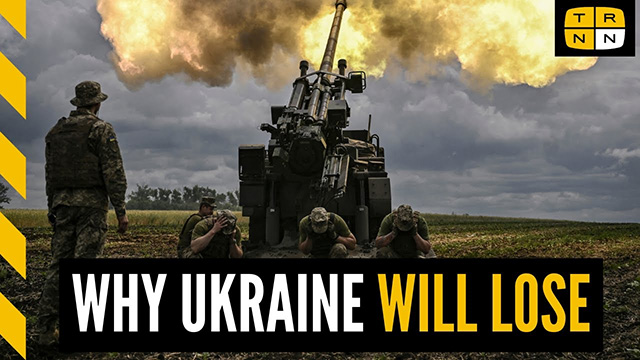
There is growing recognition in the United States and in Europe, that Ukraine can't win its war with Russia. Even pro-Biden administration outlets such as CNBC are talking about a ceasefire. This creates a dilemma from which there is no quick or easy answer, writes Stephen Bryen, a former US deputy under Secretary of Defense.
The dilemma is this: if Ukraine cannot win a war against Russia, what should the US and NATO do next?
One option is to try and get a ceasefire arrangement, hold fake negotiations with Russia, and then resume the fighting after Ukraine trains yet another army and goes on the offensive again.
But Russia won't buy that bucket of lard, since Western leaders, especially former German Chancellor Angela Merkel publicly said that the Normandy-group negotiations with Russia in 2014 and 2015 (leading to the Minsk I and Minsk II agreements) were a ruse, intended to buy time while NATO trained Ukrainian troops, put huge intelligence assets to work against Russia, and delivered massive armaments to Ukraine's army, preparing to attack once they were ready.
This lesson was a hard one, especially for Vladimir Putin, who trusted Merkle. Not anymore. He won't trust any European, but especially anyone from Germany. He now understands that all the "peace initiatives" promoted by German Chancellor Olof Schulz and French President Emmanuel Macron, were intended to deceive Russia.
Zelensky, too, has created a problem which has no exit for him. He got the Verkhovna Rada, Ukraine's parliament, to back up his Presidential decree declaring that it was illegal to negotiate with Russia until Russian troops left all of Ukraine, including Crimea. Obviously this decree not only blocks negotiations with Russia, but even if Zelensky decides to forget it, the Russians will not.
In the coming days Ukraine will organize more and more strikes on Russian assets and renew the bombing of Crimea, intending to send as harsh a message as possible to Putin. If this comes about, with US and NATO backing, it will be met by a significant Russian escalation and may help Russia decide about the war's objectives.
Until recently, Russia had two war aims in Ukraine. One was to get NATO out of the country and demilitarize Ukraine. In Russia's proposed outcome, previously Russia thought that once the war was ended on favorable terms, with NATO out and Ukraine demilitarized, Ukraine could seek security guarantees from any country of its choosing. But Russia's attitude about the war's objectives is in flux and may be changing.
Obviously, Russian territorial gains will also be on the table and Russia may want to consolidate them. But the "biggie" is Russia's vision of what a future Ukraine might look like. One template would be for Russia to keep the territorial gains and demand a change of government in Kyiv that is friendly to Russia. This can't be engineered by elections, but would have to be by some kind of coup d'etat. As there are no elections in Ukraine, a change of government can only happen by non-constitutional means.
The second template suggests that Ukraine could be broken up into three parts. Part 1 would be the Russian-annexed territories. Part 2 would be a friendly government in Kyiv. Part 3 would be a Ukraine-run “state” in Western Ukraine which might establish political links to Poland. The Russians are already talking about the need for a buffer zone to safeguard against attacks on Russian territory. With long range missiles such as ATACMS, and the possible transfer of German long range cruise missiles, especially Taurus, a buffer zone has to be well west of the Dnieper river. If the Kyiv government is overthrown, its remnants might retreat to Lvov or some other location in the west that can be shielded by NATO, thereby achieving the buffer zone.
NATO is in no position to physically relieve Ukraine with land forces. NATO has too few soldiers, and it risks leaving some NATO countries undefended and highly vulnerable, especially the Baltic states. In practice it means that if NATO actually uses direct military force in the Ukraine war, it will be with aircraft to bomb Russian military positions, or possibly attack Russia's ally, Belarus or, alternatively try and shut down Russia's strategic enclave in Kaliningrad. In 1945 the allies (including the Soviet Union) agreed at Potsdam that Kaliningrad (formerly Königsberg ) would be administered by the Soviet Union.
Others have suggested that the allies could attack Transdenistra, which is a breakaway area along the eastern border of Moldova. There is a Russian garrison in Transdenistra, but no direct land bridge for the Russians to defend the territory. While Kaliningrad is very strongly defended, Transdenistra is not.
But NATO's dilemma is that not all NATO members will agree to implement Article 5 of the Treaty to start a war with Russia. They all know they already are on very thin ice, and they lack public support for going to war for Ukraine. Furthermore, Europe's leadership ensemble is already in transition, and will be more so approaching summertime and more elections are held.
Given the fact that European arsenals are mainly exhausted, European land forces are mostly in bad shape (outside of Poland), and European air power is overrated, the best NATO policy will be to try and find a way to speak to the Russians, either before or after Ukraine's collapse, Stephen Bryen concludes.
read more in our Telegram-channel https://t.me/The_International_Affairs

 10:51 01.03.2024 •
10:51 01.03.2024 •






















